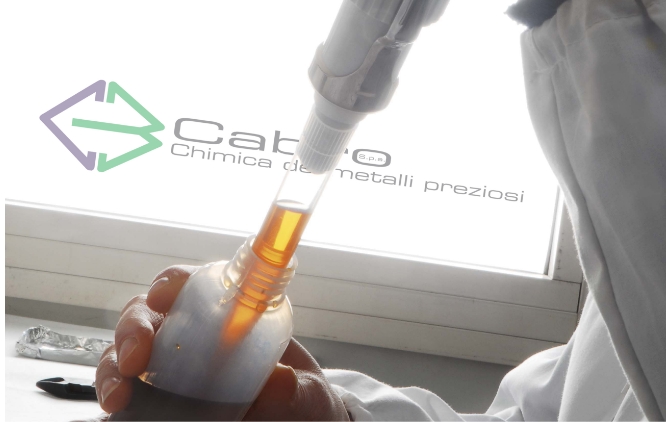Home > Innovations
The laboratory is the place where Cabro is projected into the future, that is the place where ideas and research come together in order to find accessible solutions to highly complex formulas through unexplored roads.
Our lab is the starting point for each of our new products, thanks to the reliability of state-of-the-art and highly sophisticated machinery for the analysis of precious metals.
The analytical lab uses both traditional and modern methods, that is based on advanced technologies.


For quite some time now, Cabro has been determined to foster research and innovation to find new solutions, providing a wide range of products spanning all types of international clientele. All our products are highly innovative and sophisticated from a technological and qualitative standpoint.
Tradition and innovation are thus combined, well supported by a strong commitment to the environment, in order to face every possible challenge and to always be in tune with the times in an ever-evolving market.

After 35 years hands-on experience, thanks to a strong dynamism and determination to continuously face new challenges, we continue to invest significant resources in R&D and new product design.

We collaborate with leading Italian universities and national research institutes. Over 20% of our personnel deals with research, and this has increased the number of precious metal products, of fine organic and inorganic chemicals and products for glass and ceramic decoration in our catalogue. It has also led to the birth of products that have been successfully launched on the market, for example, Safe79.

Il laboratorio Cabro è in grado di monitorare tutte le fasi produttive e di certificare il prodotto finale. Inoltre, il laboratorio effettua analisi esterne e per conto terzi, attraverso procedure e monitoraggi specializzati, con grande affidabilità nei risultati ottenuti.
I nostri servizi di laboratorio:
Fra gli strumenti in dotazione al laboratorio Cabro:
Spettrometro ad assorbimento atomico (AA) e Spettrometro ad emissione ottica (ICP-OES): strumenti impiegati per la determinazione quantitativa di ioni metallici in soluzione.
Spettrometro a fluorescenza a raggi X: strumento che attua la tecnica analitica basata sull’emissione di luce di fluorescenza da un campione esposto ai raggi X su leghe metalliche.
Spettrofotometro UV: utilizzato per misurare quantitativamente la frazione di luce che attraversa una determinata soluzione.
Cromatografo ionico: strumento che permette di separare anioni o cationi in soluzione allo scopo di analizzarli.
Potenziometro: strumento utilizzato per titolazioni in automatico su soluzioni
Viscosimetri rotazionali: strumenti impiegati per la determinazione della viscosità dei prodotti liquidi ed in pasta.
Reometro: stumento impiegato per la determinazione del comportamento reologico di prodotti in pasta.
Pigiatore volumetrico: strumento che permette la determinazione della densità dopo impaccamento di polveri e granulati.
Granulometro laser: strumento impiegato per la determinazione della granulometria di polveri e paste.
Profilometro: strumento impiegato per la determinazione della rugosità di una superficie e nello specifico dello spessore di un film conduttivo dopo cottura.
Microscopi ottici: utilizzati per l’osservazione di campioni di varia natura a vari ingrandimenti.
Microscopio elettronico a scansione (SEM) con detector a raggi X: strumento che permette l’analisi di campioni di varia natura raggiungendo una risoluzione intorno al decimo di micron. La presenza del rivelatore a raggi X permette di effettuare una microanalisi elementare sui campioni osservati al SEM.
Bilancia termogravimetrica (TGA) e calorimetro differenziale a scansione (DSC): strumento che permette di effettuare l’analisi termica di campioni liquidi o solidi.
Multimetro: strumento che permette la determinazione della resistenza elettrica di un circuito.
Strumento per la misura dell’area superficiale BET: lo strumento permette di determinare l’area superficiale specifica di una polvere tramite metodo BET, per ottenere informazioni sulle proprietà fisiche dei materiali porosi.
Spettrometro a infrarosso: stumento che fornisce informazioni strutturali su materiali, soprattutto sostanze o miscele organiche, mediante l’uso della radiazione infrarossa.
Tensiometro Digitale: strumento per la misura della tensione superficiale di un liquido.
Spettrofluorimetro: misura l’emissione di fluorescenza di un campione sottoposto a eccitazione ultravioletta.

The Cabro laboratory can supervise all production phases and certify the final product. It also performs external tests and tests on behalf of third parties, using special control and monitoring procedures, that ensure high reliability as regards the achieved results.
Our lab services:
Cabro Spa laboratory instruments include:
AA and ICP-OES Spectrometers for the quantitative determination of metal ions in solution.
X-Ray Fluorescence Spectrometer for the analytical determination of fluorescence light emissions from a sample exposed to X-rays on metal alloys.
UV Spectrophotometer for the quantitative measurement of the light fraction passing through a reference solution.
IC Ion Chromatography System that separates anions and cations in fluids so as to analyze them.
Potentiometer for automatic titration of solutions.
Rotational viscosimeters: used to measure the viscosity of liquids and pastes.
Rheometer: used to analyze the rheological behavior of pastes.
Jolting Volumeter: used to determine the packed bulk density of powders and granular materials.
Particle Size Analyzer: used to determine the particle size of powders and pastes.
Profilometer: used to analyze a surface roughness and particularly the thickness of a conductive film after firing.
Optical microscopes: used for the observation and analysis of samples of various kinds at various magnifications.
Scanning electron microscope (SEM) with X-Ray detector is used for the analysis of varied samples with a resolution of about 100 nm. The X-Ray detector enables the elemental microanalysis of the samples examined by SEM.
Thermogravimetric Analyzer (TGA) and Differential Scanning Calorimeter (DSC): used for the thermal analysis of liquid or solid samples.
Multimeter: used to determine the electrical resistance of a circuit.
BET surface area measuring instrument: the instrument allows to determine the specific surface area of a powder using the BET method, to obtain information on the physical properties of porous materials.
Infrared spectrometer: instrument that provides structural information on materials, especially organic substances or mixtures, through the use of infrared radiation.
Digital Tensiometer: instrument for measuring the surface tension of a liquid.
Spectrofluorometer: it measures the fluorescence emission of a sample exposed to UV light.